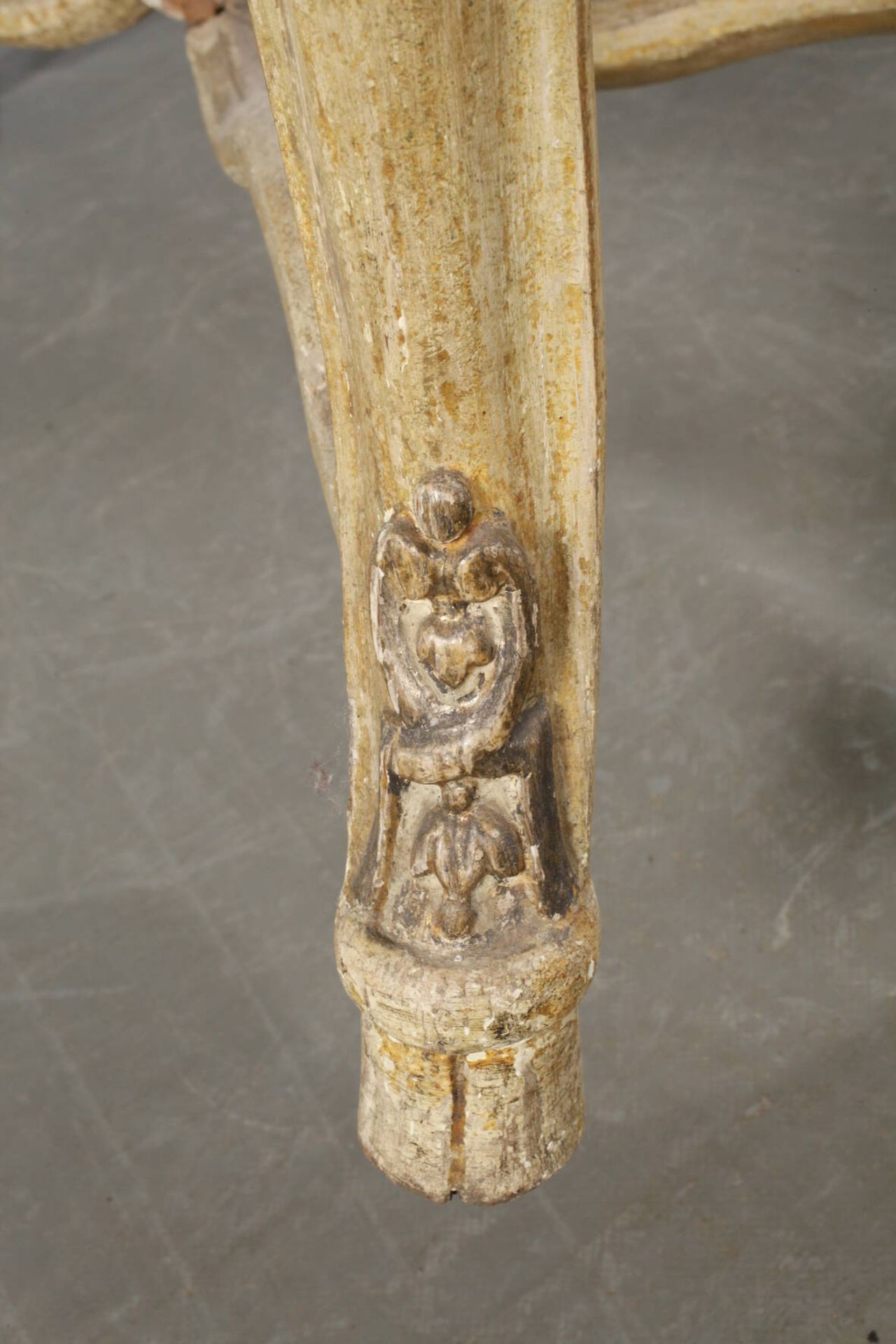8
Rehfußtisch Dresden um 1730Nadelholz und Rotbuche massiv, geschnitzt, vergoldet und farbig
1/8
Beschreibung
Rehfußtisch Dresden um 1730
Nadelholz und Rotbuche massiv, geschnitzt, vergoldet und farbig gefasst, leicht geschwungenes, reich verziertes Gestell mit godronierter Zarge, mittig mit einer Rosette, die Ecken mit Akanthusblättern verziert, die geschwungenen Beine mit geschnitzten "Rehfüßen", Verstrebung der Füße mit alt reparierter Bruchstelle, Rosette auf der Verstrebung fehlt, Fassung und Vergoldung teilweise mit Fehlstellen, Altersspuren, H 78 x B 63 x T 114 cm.
Info: Diese sogenannten Rehfuß-Tische findet man in verschiedenen sächsischen Schlössern aus der Zeit August des Starken, unter anderem im Residenzschloss Dresden, Schloss Moritzburg und im Grünen Gewölbe.
Quelle: Gisela Haase, Dresdner Möbel des 18. Jh., Kat.-Nr. 142, Abb. Farbtafel Nr. 63 und S. 312.
Deer Foot Table Dresden
around 1730, made of solid coniferous wood and red beech, carved, gilded and colored, slightly curved, richly decorated frame with gadronized frame, center with a rosette, the corners decorated with acanthus leaves, the curved legs with carved "deer feet", bracings of the feet with old repaired break, rosette on the strut missing, frame and gilding with partial defects, signs of age, H 78 x W 63 x D 114 cm. Info: These so-called deer foot tables can be found in various Saxon castles from the time of August the Strong, including the Dresden Residenzschloss, Moritzburg Castle and the Grünes Gewölbe. Source: Gisela Haase, Dresden Furniture of the 18th Century, Cat.-No. 142, ill. Color plate no. 63 and p. 312.
Nadelholz und Rotbuche massiv, geschnitzt, vergoldet und farbig gefasst, leicht geschwungenes, reich verziertes Gestell mit godronierter Zarge, mittig mit einer Rosette, die Ecken mit Akanthusblättern verziert, die geschwungenen Beine mit geschnitzten "Rehfüßen", Verstrebung der Füße mit alt reparierter Bruchstelle, Rosette auf der Verstrebung fehlt, Fassung und Vergoldung teilweise mit Fehlstellen, Altersspuren, H 78 x B 63 x T 114 cm.
Info: Diese sogenannten Rehfuß-Tische findet man in verschiedenen sächsischen Schlössern aus der Zeit August des Starken, unter anderem im Residenzschloss Dresden, Schloss Moritzburg und im Grünen Gewölbe.
Quelle: Gisela Haase, Dresdner Möbel des 18. Jh., Kat.-Nr. 142, Abb. Farbtafel Nr. 63 und S. 312.
Deer Foot Table Dresden
around 1730, made of solid coniferous wood and red beech, carved, gilded and colored, slightly curved, richly decorated frame with gadronized frame, center with a rosette, the corners decorated with acanthus leaves, the curved legs with carved "deer feet", bracings of the feet with old repaired break, rosette on the strut missing, frame and gilding with partial defects, signs of age, H 78 x W 63 x D 114 cm. Info: These so-called deer foot tables can be found in various Saxon castles from the time of August the Strong, including the Dresden Residenzschloss, Moritzburg Castle and the Grünes Gewölbe. Source: Gisela Haase, Dresden Furniture of the 18th Century, Cat.-No. 142, ill. Color plate no. 63 and p. 312.
Auktionsdetails
Versand
AGB & Wichtige Informationen
Stellen Sie dem Verkäufer eine Frage
Rehfußtisch Dresden um 1730
Nadelholz und Rotbuche massiv, geschnitzt, vergoldet und farbig gefasst, leicht geschwungenes, reich verziertes Gestell mit godronierter Zarge, mittig mit einer Rosette, die Ecken mit Akanthusblättern verziert, die geschwungenen Beine mit geschnitzten "Rehfüßen", Verstrebung der Füße mit alt reparierter Bruchstelle, Rosette auf der Verstrebung fehlt, Fassung und Vergoldung teilweise mit Fehlstellen, Altersspuren, H 78 x B 63 x T 114 cm.
Info: Diese sogenannten Rehfuß-Tische findet man in verschiedenen sächsischen Schlössern aus der Zeit August des Starken, unter anderem im Residenzschloss Dresden, Schloss Moritzburg und im Grünen Gewölbe.
Quelle: Gisela Haase, Dresdner Möbel des 18. Jh., Kat.-Nr. 142, Abb. Farbtafel Nr. 63 und S. 312.
Deer Foot Table Dresden
around 1730, made of solid coniferous wood and red beech, carved, gilded and colored, slightly curved, richly decorated frame with gadronized frame, center with a rosette, the corners decorated with acanthus leaves, the curved legs with carved "deer feet", bracings of the feet with old repaired break, rosette on the strut missing, frame and gilding with partial defects, signs of age, H 78 x W 63 x D 114 cm. Info: These so-called deer foot tables can be found in various Saxon castles from the time of August the Strong, including the Dresden Residenzschloss, Moritzburg Castle and the Grünes Gewölbe. Source: Gisela Haase, Dresden Furniture of the 18th Century, Cat.-No. 142, ill. Color plate no. 63 and p. 312.
Nadelholz und Rotbuche massiv, geschnitzt, vergoldet und farbig gefasst, leicht geschwungenes, reich verziertes Gestell mit godronierter Zarge, mittig mit einer Rosette, die Ecken mit Akanthusblättern verziert, die geschwungenen Beine mit geschnitzten "Rehfüßen", Verstrebung der Füße mit alt reparierter Bruchstelle, Rosette auf der Verstrebung fehlt, Fassung und Vergoldung teilweise mit Fehlstellen, Altersspuren, H 78 x B 63 x T 114 cm.
Info: Diese sogenannten Rehfuß-Tische findet man in verschiedenen sächsischen Schlössern aus der Zeit August des Starken, unter anderem im Residenzschloss Dresden, Schloss Moritzburg und im Grünen Gewölbe.
Quelle: Gisela Haase, Dresdner Möbel des 18. Jh., Kat.-Nr. 142, Abb. Farbtafel Nr. 63 und S. 312.
Deer Foot Table Dresden
around 1730, made of solid coniferous wood and red beech, carved, gilded and colored, slightly curved, richly decorated frame with gadronized frame, center with a rosette, the corners decorated with acanthus leaves, the curved legs with carved "deer feet", bracings of the feet with old repaired break, rosette on the strut missing, frame and gilding with partial defects, signs of age, H 78 x W 63 x D 114 cm. Info: These so-called deer foot tables can be found in various Saxon castles from the time of August the Strong, including the Dresden Residenzschloss, Moritzburg Castle and the Grünes Gewölbe. Source: Gisela Haase, Dresden Furniture of the 18th Century, Cat.-No. 142, ill. Color plate no. 63 and p. 312.
100. Auktion 17.-21. November 2020
Auktionsdatum
Für Auktionshaus Mehlis Versandinformtation bitte wählen Sie +49 3741 221005.

























